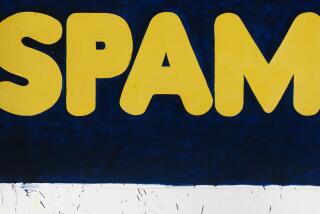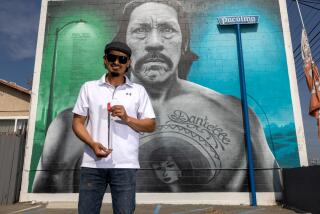Celebrating the Chicana/o murals of L.A., some lost forever, with ‘¡Murales Rebeldes!’
“Who has the right to tell history? Who has the right to occupy public space?” asks Erin M. Curtis, a co-author of the new book “¡Murales Rebeldes! L.A. Chicana/o Murals Under Siege” in which she explains, “Chicana/o muralists have long explored similar questions.”
Published by Angel City Press, “¡Murales Rebeldes!” is being published alongside an exhibition of the same name that is part of Pacific Standard Time: LA/LA, the citywide art festival that begins in September. On Sunday, before the exhibits begin, writers and artists in the book will appear at Vroman’s bookstore in conversation with Gustavo Arrellano, editor of the OC Weekly.
The Chicana/o murals from the 1970s-1990s included in the book — some of which were whitewashed or destroyed, others currently in peril of deteriorating to the point of being forgotten — reveal themselves to be microcosms of the city; presented together, their collective histories tell a greater story about L.A.
Collaborative and community-based, murals are public records of not only the narratives of the artists who created them, but are also, as co-author Jessica Hough writes, “art as social practice.” Many of the works in “¡Murales Rebeldes!” reflect the Chicano movement from which they emerged. “These wall paintings are and can become springboards for necessary community dialogues,” adds co-author Guisella Latorre, “about racism, exclusion, power, violence.”
They’re also springboards for conversations about what constitutes art.
Take the mural “Filling Up on Ancient Energies,” which was completed by the artist collective the East Los Angeles Streetscapers at the corner of 4th and Soto streets in Boyle Heights in 1980 only to be destroyed in 1988 by Shell Oil to make room for a parking lot. In a pivotal incident, the East Los Angeles Streetscapers sued Shell Oil under jurisdiction of the California Art Preservation Act; after an initial loss and a series of appeals, their efforts spurred a new ruling. “The artists obtained official legal acknowledgment that in California,” writes Curtis, “murals are, in fact, art.”
It seems ludicrous to categorize murals otherwise, especially in Los Angeles, where they are “as essential a part of the region’s graphic identity as Googie and Mission revival architecture,” writes Gustavo Arellano in the foreword. And yet “¡Murales Rebeldes!” examines the many ways that these works were and are disregarded, desecrated and defaced. Dismissing the importance of Chinana/o murals is tantamount to “silencing of Chicanas/os’ right to greater visibility and to shape the spaces where they live,” writes Latorre.
A bucket of white paint defaced a controversial panel of Sergio O’Cadiz Moctezuma’s “Fountain Valley Mural” that depicted police in riot gear; Roberto Chavez’s “The Path to Knowledge and the False University” was whitewashed less than four years after its completion. Deeply researched and photo-documented, the pages of “¡Murales Rebeldes!” serve as “mini-altars to works not seen for years, sometimes decades,” writes Arellano.
The pages of “¡Murales Rebeldes!” are a wake-up call to put the phone down when walking the streets of L.A. and look up. There are splashes of color on our walls, some fresh, some sun-faded, all a vital part of the story of this place. “Know your Southern California history,” urges Arellano. “Whether you’re Chicana/o or not, the murals are part of our narrative.”
More to Read
Sign up for our Book Club newsletter
Get the latest news, events and more from the Los Angeles Times Book Club, and help us get L.A. reading and talking.
You may occasionally receive promotional content from the Los Angeles Times.








